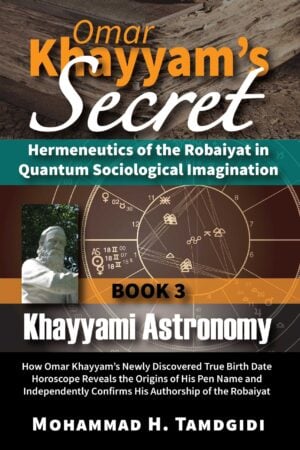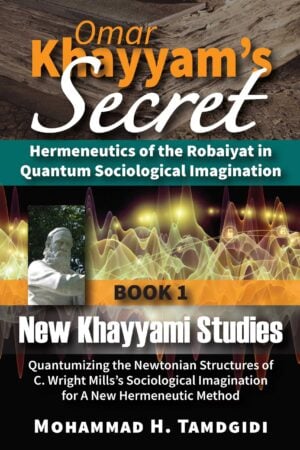Book Section: CHAPTER II — Hermeneutic Analysis of Clauses 1-19 of Omar Khayyam’s Treatise on the Science of the Universals of Existence: Descending the Succession Order — by Mohammad H. Tamdgidi
$20.00
This essay, titled “Hermeneutic Analysis of the Clauses 1-19 of Omar Khayyam’s Treatise on the Science of the Universals of Existence” is the second chapter of the book Khayyami Philosophy: The Ontological Structures of the Robaiyat in Omar Khayyam’s Last Written Keepsake Treatise on the Science of the Universals of Existence, which is the fourth volume of the twelve-book series Omar Khayyam’s Secret: Hermeneutics of the Robaiyat in Quantum Sociological Imagination, authored by Mohammad H. Tamdgidi.
Description
Abstract
This essay, titled “Hermeneutic Analysis of the Clauses 1-19 of Omar Khayyam’s Treatise on the Science of the Universals of Existence” is the second chapter of the book Khayyami Philosophy: The Ontological Structures of the Robaiyat in Omar Khayyam’s Last Written Keepsake Treatise on the Science of the Universals of Existence, which is the fourth volume of the twelve-book series Omar Khayyam’s Secret: Hermeneutics of the Robaiyat in Quantum Sociological Imagination, authored by Mohammad H. Tamdgidi.
In this chapter Tamdgidi begins a clause-based hermeneutic analysis of Omar Khayyam’s last written treatise on the universals of existence, focusing on the clauses 1-19 of the treatise. To avoid a long chapter, he splits this investigation into two chapters (the second to follow the present one), keeping in mind that conclusions about the overall treatise can be made only after exploring it as a whole.
In his textual analysis the author abstracts from the question of the intellectual and historical context of this treatise and of the question of the historical-biographical identity of the person who requested this treatise from Khayyam and therefore to whom it is addressed, intending to come back to such important contextual questions at the end of this analysis.
The introduction to the treatise indicates Khayyam considered it to be uniquely significant to his work, offering a synopsis containing new thoughts not found in previous writings as such, considering it a brief essay that is worth volumes. So, the treatise invites careful analysis.
While trying to understand where Khayyam stands in the millennial debate about the universal attributes of existence, and whether they are objectively given and/or subjectively created, we should keep in mind and recognize that he is not taking up just another philosophical topic to explore in his treatise. He is taking the philosophical topic of his time, and perhaps of all time, one that has remained a “problem” down to the present time. And in offering his views, Khayyam seems to be claiming that he has found a solution—offering a brief treatise worth volumes. His further brief elaborations indicates that, despite being offered in its universal and synoptic outlines, Khayyam considered it possible that his theory of existence could lead his audience to further details of his worldview.
The basic points of the clauses 1-19 of Khayyam’s treatise as examined in this chapter may be summarized as follows:
1. There is absolutely no question that Khayyam was a believer in one God as a Necessary Being, and that he regarded the universe as a possible existence created by God. Khayyam clearly made a distinction between God’s necessary existence and the possible existence of the universe as a substance; this is apparent when he says all existence, except that of God, is substance.
2. The universe of possible existence being a substance means that he regarded it as being relatively (within the bounds of creation as set by God) self-reliant, self-knowing, and self-creative, taking on a fragrance of the assumed absolute attributes of its creator.
3. This universe of possible existence created by God did not come about at once in its present form. According to Khayyam it came about through a process he calls “succession order” or “sequential order,” something akin to what we regard as an “evolutionary” processes. So, Khayyam is basically advancing a creationist-evolutionary worldview in this treatise.
4. The multiplicities we find in our world of possible existence are not to be conceived, logically, in terms of “levels” or “onion rings” as if separable from one another. The whole universe is just one substance evolving, taking on different forms that appear to us as if separately existing, but in fact they are all evolving folds of the one reality of universal substance.
5. Khayyam distinguishes between essentially two types of substance, the indivisible spirit and the divisible body. The indivisible spirit is itself of two kinds, intellect and self (or soul). So, basically all existence is comprised of these three names and forms, suggesting that all possible existence created by God is of one substance, and the spirit and the body are both, still, of the same substance characterized by the attributes of self-reliance, self-reflection, and self-creativity.
6. The created universe of possible existence in which we find ourselves is itself in search of its Beloved Source. The first substance was intellect, or consciousness. This first active universal intellect is relatively self-reliant, self-knowing, and self-creative, so is itself wondering who it is, where it comes from, and where it is going. Its consciousness becomes “split” into the folds of knowing its origins, who it is, and where it is going, bringing about the distinction between the intellect, the self, and the sphere. Again, it is crucial in Khayyam’s worldview to consider the holism of the world’s existence as a substance. Universal self is the universal intellect reflecting on itself, and universal sphere is that self setting in motion in search of its Beloved Source.
7. It is the search of the active intellect for its Beloved Source that basically underlies the unfolding of everything in the universe created by God. Love plays a key role as an included middle element in the unfolding logic of this universe, since everything is motivated by the love to know its source, and in turn motivates the movement of searching for that source. The various folds of the active universal intellect, being universally self-reflective, and setting the universal sphere in motion are then listed by Khayyam in terms of their infinite variety of which he distinguishes the ten intellects, souls, and spheres associated in a ten-fold triadic architecture down the descending arc or curve of creation, associated with the sphere of the fixed stars, sphere of the spheres, spheres of the Saturn, of Jupiter, of Mars, of the Sun, of Venus, and of the Moon. Below the last sphere, of the Moon, is the Earthly world of elements evolving into natural compounds, through the forms of solids, planets, animals, culminating in the final human form.
8. Once humankind appears in the succession order, it can begin its journey back along the ascending evolutionary succession order in search of its Beloved Source. But here, according to Khayyam, potential humankind must take a conscious and intentional step to actually become humankind, and for this it has to realize its place in the succession order, where it comes from, and where it is going. Without such a realization, it is not properly living a life deserving of humanity, since humanity is essentially spirit, not body.
9. All intellects, selves, and spheres on and above the Moon, according to Khayyam, are relatively speaking enduring (within the bounds of a created world since the only immortal and necessary being is God). However, below the sphere of the Moon, on Earth, we have a world of generation and decline, where all forms are transient, including human life. So, human body has a very limited lifetime’s opportunity to become aware of its place in the evolutionary succession order, in order to consciously and intentionally organize its collective and personal life as a self-reliant, self-knowing, and self-creative being, making it possible to cultivate and develop its indivisible spiritual powers of self-knowledge and its self-creative talents despite any fettering distractions his or her attachments to the divisible world of the body may pose.
10. So, for Khayyam, so long as humankind fails to awaken to its own nature in the play of creation and to realize that it is essentially spirit and of the same spiritual substance as the universal substance of consciousness originally created by God in His own image as a self-reliant, self-knowing, and self-creative substance, it will endure a life of suffering and end in destruction.
Recommended Citation
Tamdgidi, Mohammad H. 2021. “CHAPTER II — Hermeneutic Analysis of Clauses 1-19 of Omar Khayyam’s Treatise on the Science of the Universals of Existence: Descending the Succession Order.” Pp. 45-120 in Omar Khayyam’s Secret: Hermeneutics of the Robaiyat in Quantum Sociological Imagination: Book 4: Khayyami Philosophy: The Ontological Structures of the Robaiyat in Omar Khayyam’s Last Written Keepsake Treatise on the Science of the Universals of Existence. (Human Architecture: Journal of the Sociology of Self-Knowledge: Vol. XVII, 2021. Tayyebeh Series in East-West Research and Translation.) Belmont, MA: Okcir Press.
Where to Purchase Complete Book: The various editions of the volume of which this Book Section is a part can be ordered from the Okcir Store and all major online bookstores worldwide (such as Amazon, Barnes&Noble, Google Play, and others).
Read the Above Publication Online
To read the above publication online, you need to be logged in as an OKCIR Library member with a valid access. In that case just click on the large PDF icon below to access the publication. Make sure you refresh your browser page after logging in.






